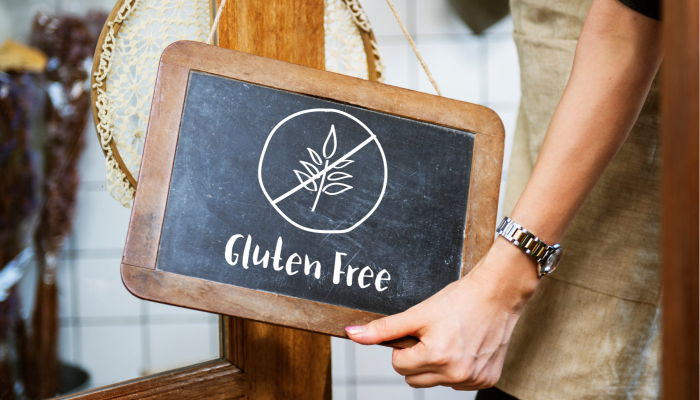Understanding & Navigating Gluten-Free Living
By Guest Blogger Tracy Huneycutt
More people are developing gluten issues as compared to years past Experts believe this could be occurring for several reasons. For example, one such reason being that our stomachs have not adapted to the altered state of wheat grains over the last several decades. Meanwhile, some believe that the clean and sterile modern environment we live in accounts for weaker antibodies. Immune systems overreact and may attack undigested gluten particles considered to be microbial invaders.
For those that don’t know what gluten is. It is found in wheat, oat, barley, and rye.
People who have a family history of auto-immune diseases, allergies, or allergic diseases, such as asthma or eczema, are more likely to develop Celiac disease, a gluten allergy, or gluten intolerance.
Various Diseases & Issues Requiring Gluten-Free Living
Celiac disease is an immune reaction to eating gluten, a natural protein found in wheat, barley, and rye. Over time, this creates inflammation that damages the small intestine’s lining, leading to medical complications. Celiac disease can manifest at any age. The most common signs of Celiac disease are often diarrhea, abdominal pain or discomfort, bloating, fatigue, and anemia.
A gluten allergy develops when the body’s immune system becomes sensitized and overreacts to gluten ingredients. Some possible signs of a gluten allergy include hives or a skin rash, digestive issues (nausea, vomiting, abdominal pain,) a stuffy or runny nose, sneezing, and headaches. Less common is anaphylaxis, a potentially life-threatening reaction.
Finally, a gluten intolerance is when a person becomes sick after eating gluten. They typically feel bloated, gassy, or tired.
My Family’s Gluten-Free Journey
My husband was diagnosed with Celiac in 2011. Over the past year, our 10-year-old son began to show indications of developing a gluten allergy. For individuals and families faced with the reality of switching to a gluten-free lifestyle due to Celiac, gluten allergies, or gluten intolerance, the initial understanding and planning involved often seems daunting. I wanted to offer some information and insight that will hopefully be of service to those who are getting started understanding this way of life.
Our family prepares and eats most of our meals at home, for reasons of cost and food safety. When we do go out to eat, we usually frequent the same group of fast-food establishments and restaurants where we know food is prepared safely. For those with Celiac or gluten allergies, gluten-free foods must be prepared where no cross-contamination with gluten ingredients will occur. The reason for this is cross-contamination will potentially cause illness. For instance, a separate fryer for different foods is necessary. If fries are cooked in the same fryer as breaded meats, this would not be safe.
Traveling & the Gluten-Free Lifestyle
When traveling or trying a new restaurant, referring to apps like “Find Me Gluten-Free” are helpful. This app allows individuals to share their experiences with food safety and a staff’s understanding of gluten when eating at restaurants. We often call ahead of time to ensure that the cooking staff is well-versed in safely preparing food for those with Celiac and gluten allergies. If the staff appears uninformed about what gluten-free means or cannot guarantee that cross-contamination with gluten ingredients will not occur, we err on the side of caution and do not order from there.
The encouraging news is that more restaurants are aware of how to prepare gluten-free food safely and are better educated in explaining to guests which foods on their menu would be safe to eat. We recently traveled to Universal Studios in Florida. The waitstaff and cooks there were familiar with what meals could be safely consumed, as well as the need to prepare gluten-free items separately. Even if we had to wait a little longer for some of our meals, it was worth it to ensure no sickness would occur.
Gluten-Free Options Today
When we attend get-togethers, potlucks, or cookouts, I always bring separate food for my husband and son. I do not want to put pressure on family members or friends to attempt to safely prepare a gluten-free dish (especially if the hosts are not familiar with doing so. Wheat by-products and fillers are found in surprising places, like seasonings and marinades.)
Gluten-free foods are more expensive than their non-gluten-free counterparts. As a family, we have adjusted to the grocery bill increase. Unfortunately there is no safe way around it. Gluten-free food simply costs more because of the ingredients used and the extra care needed.
How to Eat & Shop Gluten-Free
We focus many of our meals around naturally gluten-free foods. Beef, chicken, pork, fish, eggs, fruits, vegetables, potatoes, and corn are all naturally gluten-free foods. We snack on nuts, seeds, trail mixes, yogurts, cheese, smoothies, and peanut butter. We love preparing salads in the spring and summer, and soups in the fall and winter. I make homemade seasonings, marinades, and salad dressings, and look to Pinterest for the majority of my gluten-free recipes and meal inspirations.
Reading ingredient labels on grocery store purchases, especially frozen foods and boxed foods, is essential. Even if a food is advertised as “Gluten-Free,” when reading the fine print around the ingredient list, it may indicate that the food is made in a facility that also processes gluten ingredients. We avoid those foods as a safety precaution.
Current Gluten-Free Products
Trying gluten-free products is a trial-and-error process. There are some brands that taste amazing in my opinion. Then, there are some snacks and replacements we have tried that we did not care for at all. Although we try to eat chips, crackers, graham crackers, pastas, sweets, baked goods, and the like in moderation, we have found many gluten-free products that taste just as good as their non-gluten-free counterparts.
Adjusting to the texture and taste of some gluten-free items can take time, especially for pickier eaters. My husband opts to eat burgers wrapped in lettuce, as he finds gluten-free buns too dense. When preparing bread for sandwiches, we toast the bread to improve the texture.
Navigating gluten-free living often feels challenging initially, but it does get easier over time. Asking questions and reading food labels are necessities for safely traversing a gluten-free lifestyle. Any child or adult who believes they may have developed an undiagnosed gluten allergy or Celiac disease should seek the advice of their doctor before changing their diet.
Want to see more blogs like this and also get notifications on local events and happenings? Subscribe to our free weekly newsletters here.







